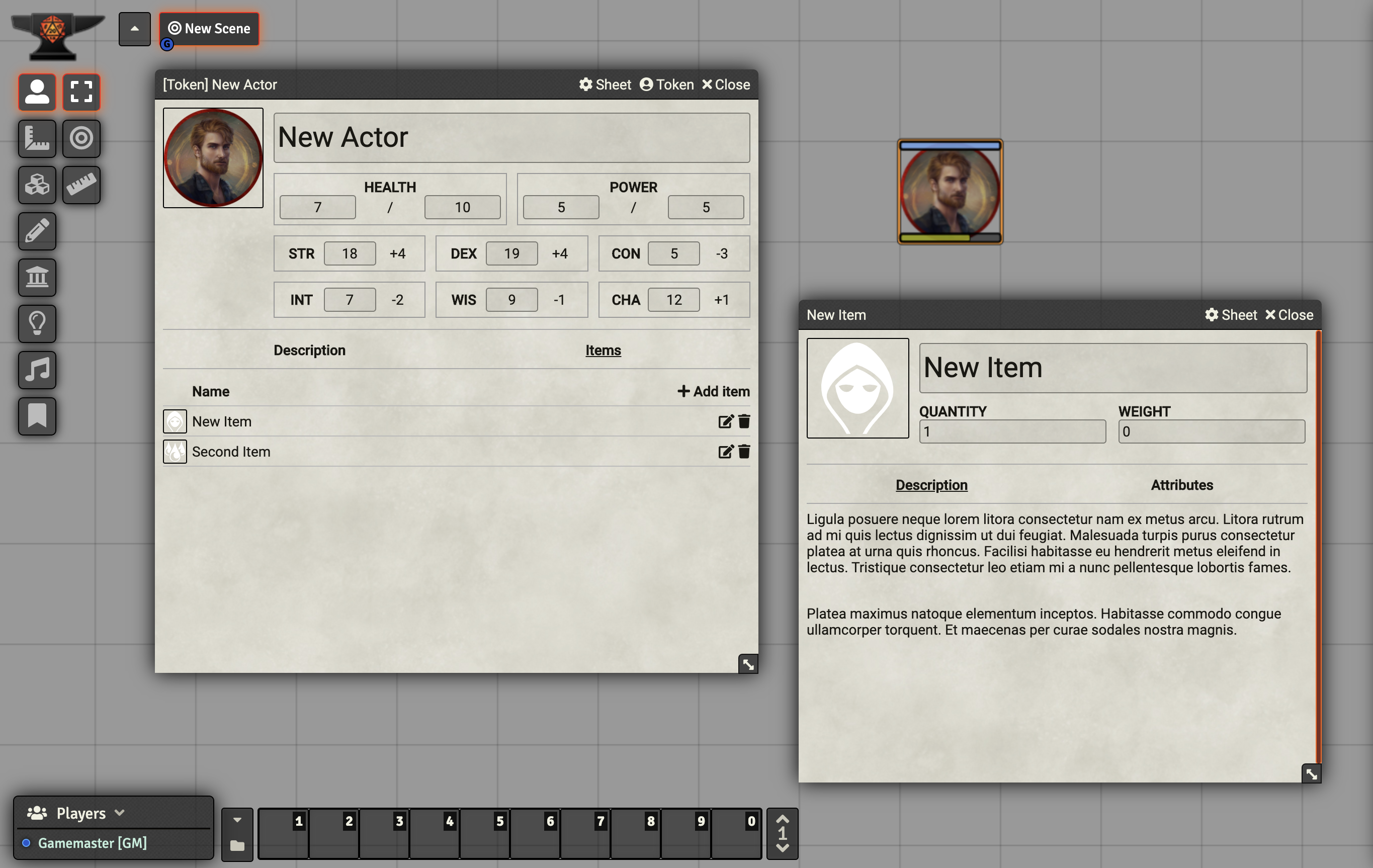This system is a boilerplate system that you can use as a starting point for building your own custom systems. It's similar to Simple World-building, but has examples of creating attributes in code rather than dynamically through the UI.
There are two ways to get started: using the Boilerplate system generator command or manually renaming and updating files.
Regardless of which method you choose, think carefully about your system's name. Your system's package name when submitted to Foundry must be formatted like alphanumeric-lowercase, and it must be unique. Check the Foundry systems package list for conflicts before committing to a name!
Data Models
If you would like to use DataModel classes instead of the older template.json configuration, you'll need to use the
npm run generatecommand described below and choose to enable them when asked. DataModels are currently an optional feature, and are only availabe in the generator CLI due to that.
This system includes a generator CLI in package.json. To use it, you must have node.js installed, and it's recommended that you install node 20 or later.
Python Generator
If you would rather use Python than node, there’s an excellent Python-based generator created by Cussa at https://github.com/Cussa/fvtt-boilerplate-initializator. Give it a shot!
Once you have npm installed, you can run the following in your terminal or command prompt:
npm install
npm run generateYour terminal should prompt you to name your system. Read the instructions carefully, the letter case and special characters in each question matter for correct system generation.
Once the generator completes, it will output your system to build/<your-system-name>, where <your-system-name> is the package name you supplied during the prompt.
Copy this directory over to your Foundry systems directory and start coding!
Before installing this system, you should rename any files that have boilerplate in their filename to use whatever machine-safe name your system needs, such as adnd2e if you were building a system for 2nd edition Advanced Dungeons & Dragons. In addition, you should search through the files for boilerplate and Boilerplate and do the same for those, replacing them with appropriate names for your system.
The name property in your system.json file is your system's package name. This need to be formatted alphanumeric-lowercase, and it must also match the foldername you use for your system.
NOTE: The Vue 3 version is currently outdated and considered an advanced usage of Foundry due to it being a custom renderer. Only try it out if you really like Vue and are feeling dangerous!
Alternatively, there's another build of this system that supports using Vue 3 components (ES module build target) for character sheet templates.
Head over to the Vue3Boilerplate System repo if you're interested in using Vue!
Check out the Official Foundry VTT Discord! The #system-development channel has helpful pins and is a good place to ask questions about any part of the foundry application.
For more static references, the Knowledge Base and API Documentation provide different levels of detail. For the most detail, you can find the client side code in your foundry installation location. Classes are documented in individual files under resources/app/client and resources/app/common, and the code is collated into a single file at resources/app/public/scripts/foundry.js.
For much more information on how to use this system as a starting point for making your own, see the full tutorial on the Foundry Wiki!
Note: Tutorial may be out of date, so look out for the Foundry compatibility badge at the top of each page.
This system includes a handful of helper CSS classes to help you lay out your sheets if you're not comfortable diving into CSS fully. Those are:
flexcol: Included by Foundry itself, this lays out the child elements of whatever element you place this on vertically.flexrow: Included by Foundry itself, this lays out the child elements of whatever element you place this on horizontally.flex-center: When used on something that's using flexrow or flexcol, this will center the items and text.flex-between: When used on something that's using flexrow or flexcol, this will attempt to place space between the items. Similar to "justify" in word processors.flex-group-center: Add a border, padding, and center all items.flex-group-left: Add a border, padding, and left align all items.flex-group-right: Add a border, padding, and right align all items.grid: When combined with thegrid-Ncolclasses, this will lay out child elements in a grid.grid-Ncol: ReplaceNwith any number from 1-12, such asgrid-3col. When combined withgrid, this will layout child elements in a grid with a number of columns equal to the number specified.
This repo includes both CSS for the theme and SCSS source files. If you're new to CSS, it's probably easier to just work in those files directly and delete the SCSS directory. If you're interested in using a CSS preprocessor to add support for nesting, variables, and more, you can run npm install in this directory to install the dependencies for the scss compiler. After that, just run npm run build to compile the SCSS and start a process that watches for new changes.


